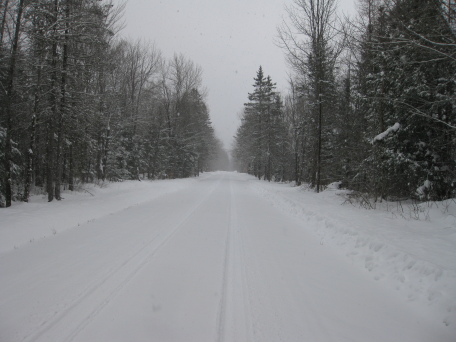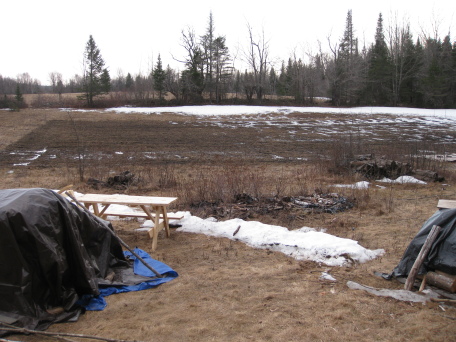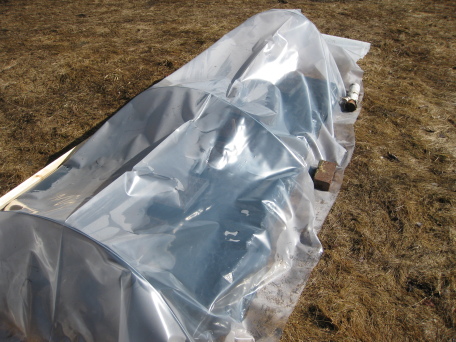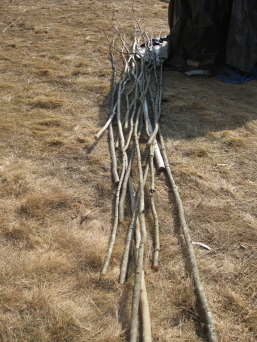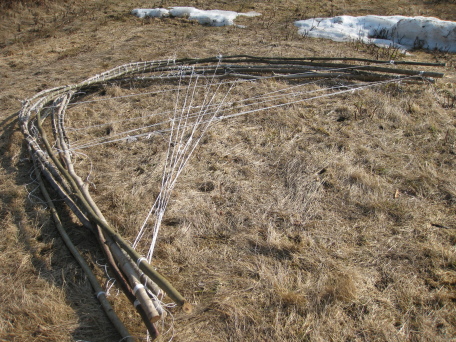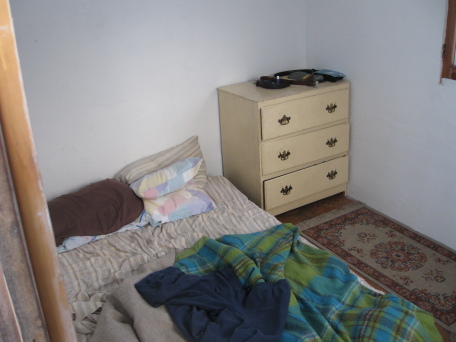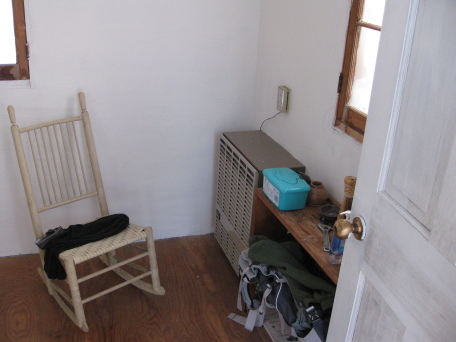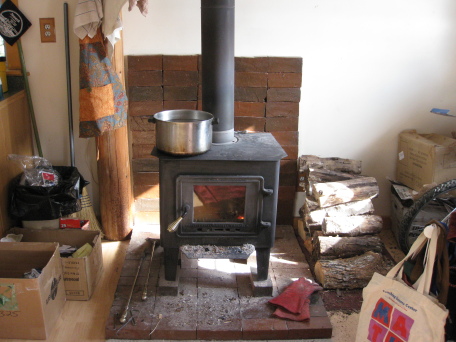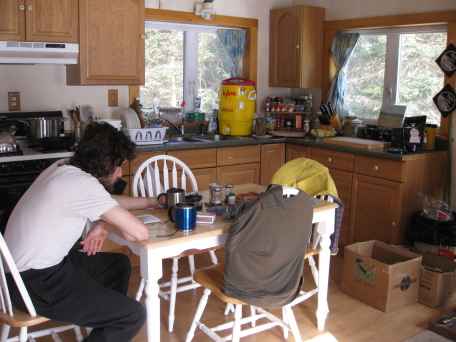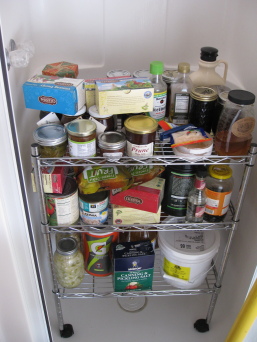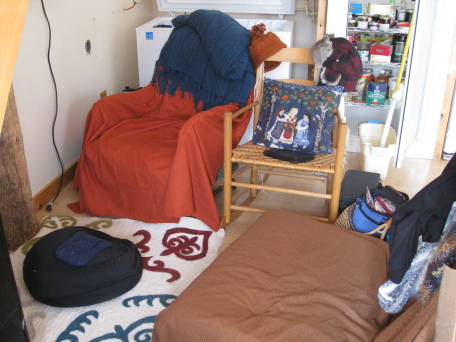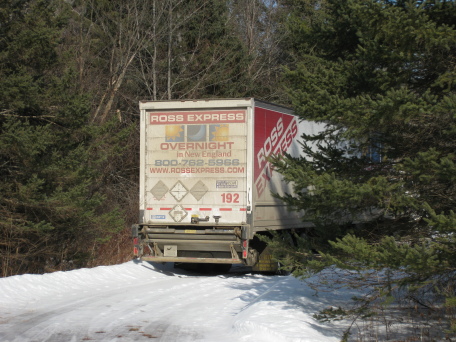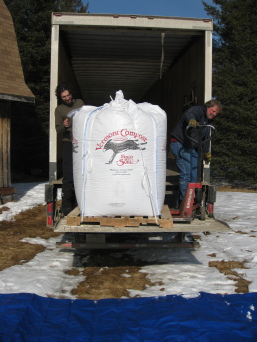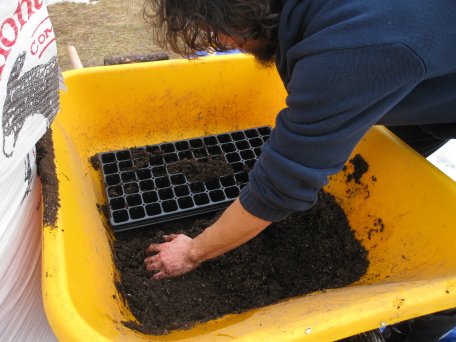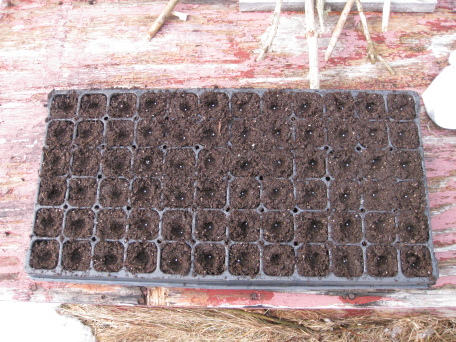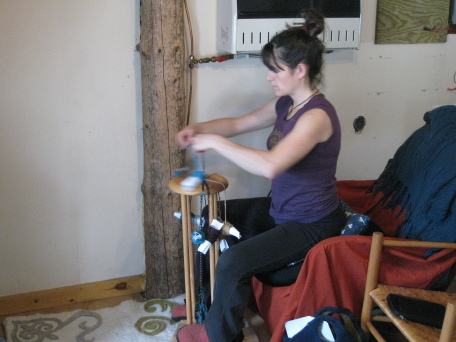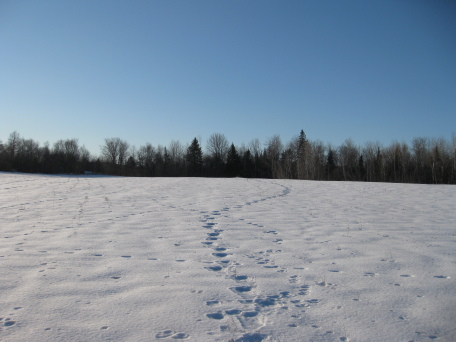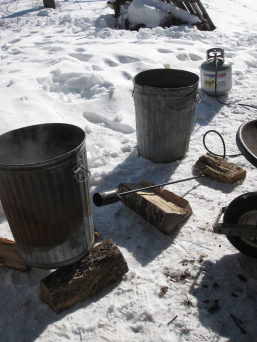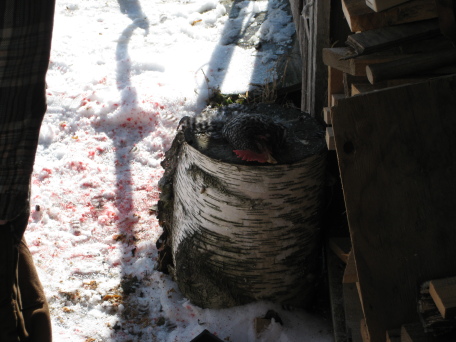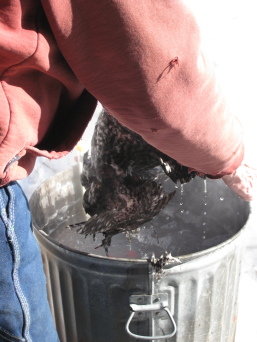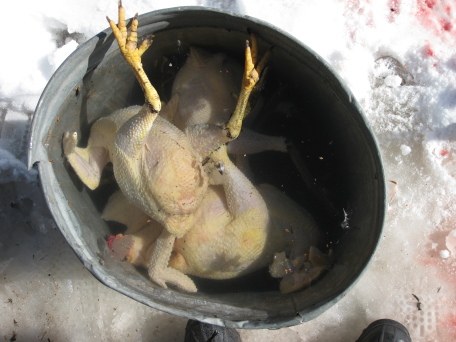A Taste Of Spring
by jean-paul | March 20, 2012 at 12:00 PM | categories: building, maine, seedlings | View CommentsBy the reckoning of some, spring is now upon us. This might not be much of an occassion in central Maine in years past, but the last few days up here have been decidely spring-like, at times verging on summerful. Just a few short weeks ago we were taking snowy walks through biting wind. Now the sun is shining, the temperature is up around 18°C (mid 60s for you Americans), and the snow is fading fast.
The warm sunny days give us a great opportunity to get our seedlings out where they can thrive. We're up to almost thirty trays of seedlings now, and there's not nearly enough light for them inside, even co-opting my mom's seed bench. The hoop house is still a day or two away, so for now we have a make-shift low tunnel in our front yard.
The hoop house is coming along, though. We cut all the saplings and started getting them used to their new shape. At the same time, we also cut some smaller wood to use for low tunnels later on the season.
Nights are still a little bit chilly up here (down to freezing last night, for example), and it'll probably snow at least once more, so it's not clear when we'll actually be able to leave anything outside overnight. And the field has some drying out to do before we'll be transplanting anything into it.
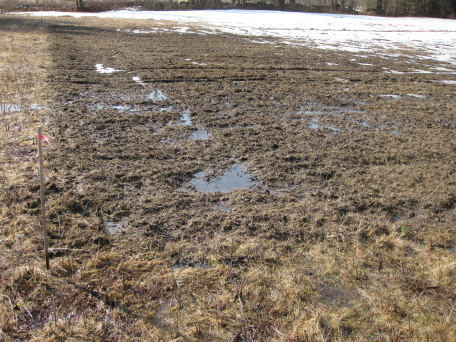
Some exciting stuff is coming up. I'm glad to be back from California and not have any more major travel planned. And speaking of excitment, Jericho had some while I was away. I won't tell the story, but I have to post one of the pictures she took.
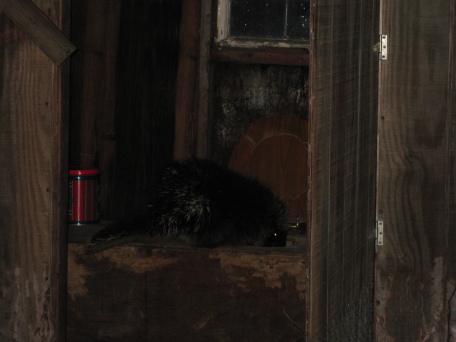
Happy spring, everyone.
Winter's Bounty
by jericho | March 11, 2012 at 10:30 AM | categories: food, building, maine, seedlings | View CommentsOur recent rash of snow storms has thrown us back into what feels like the depths of winter and for some reason this inspired me to write about food. Perhaps because one of my favorite things to do on a stormy day is to stay in and cook. Also, this is an interesting time of year for those trying to "eat local" because stored produce is starting to run out, and the first spring greens have yet to arrive.
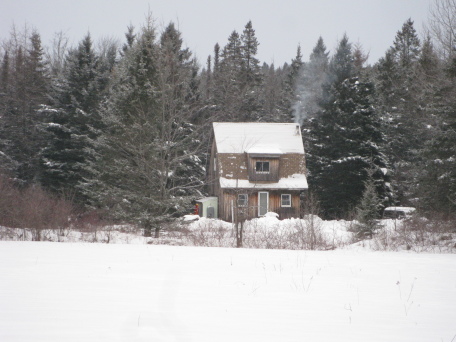
Last summer I did quite a bit of canning and freezing to preserve the delicious produce from Waltham Fields Community Farm for later use. We tried to eat a lot of it before moving (so that there was less to move), but I was pleased to find some greens, applesauce, and a few other goodies in the freezer when we got here in February. We also still had a few jars of sauerkraut (everyone should try to make this! A great recipe can be found here) that I had canned, which is delicious although sadly not alive anymore (because the heat required for canning kills all of the good lactobacillus in the live kraut).
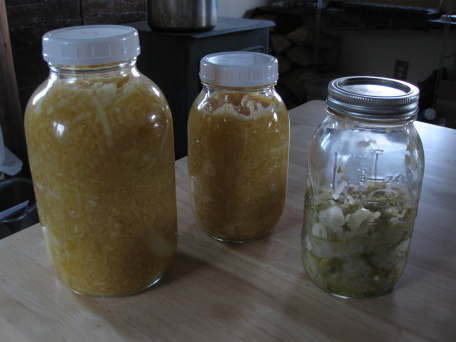
However, the fruits of last summer's labor are not enough to live on so when we first arrived in Dover-Foxcroft, I did a little searching and was thrilled to find out that Ripley Farm has delicious root vegetables and other storage crops that can be ordered and picked up every other week until the end of March! We are also lucky to have Widdershins Farm and Maple Lane Farm close by so that we can get local meat and eggs.
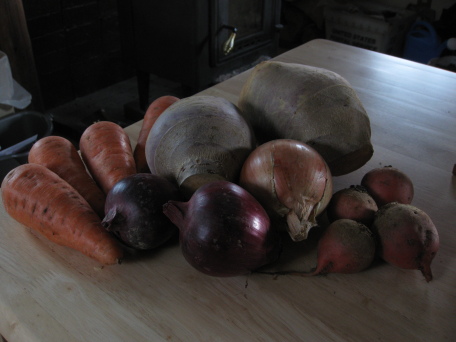
What are we making with these fabulous ingredients, you ask? One of my favorites is a chili recipe that I made up that has no tomatoes in it (since anything in the nightshade family is on my dietary "no list" unfortunately). Pureed carrots take the place of the tomatoes as a base, with a little bit of tamarind paste and/or apple cider vinegar to give it that tomato-y kick. Granted, tamarind paste is not local, nor are the many spices that really turn this into chili, but carrots and ground beef make up the bulk of this tasty dish so it is a great winter local meal. Here's the recipe in case you want to give it a try:

INGREDIENTS
4 lbs Carrots
2 T Olive Oil
1 Onion
1 1/2 lbs Ground Beef
2 cloves Garlic
2 tsp Cumin
2 tsp Celery Seed
1/4 tsp Cloves
1/4 tsp Cinnamon
1 1/2 tsp Oregano
1 Bay Leaf
2 C Water or Stock
1/4 C Apple Cider Vinegar
1/4 tsp Tamarind Paste (optional, but tasty)
DIRECTIONS
Cook carrots and mash or puree. I cook mine in the pressure cooker, but you could steam, boil, or roast them depending on what works for you.
In large saucepan, saute onions in olive oil over medium heat until translucent. Add meat and garlic and cook until meat is browned.
Add spices, water or stock, carrot puree, apple cider vinegar, and tamarind paste. If using a pressure cooker, bring to pressure and cook for 15 minutes. If not, bring to a boil and simmer for 1-2 hours.
I also decided to embark on a new fermenting adventure and try making sauerruben, which is like sauerkraut, but made with turnips or rutabaga instead. You can see what this looks like in the picture of my sauerkraut earlier. The fermenting rutabaga is the one that is very orange. The only complaint I have about sauerruben so far is that it requires grating a large quantity of rutabaga: I made this two days ago and my hands, neck, and arms are still sore.
In other news, we ended up moving our seedlings over to Lori's house because they were not getting enough light in the cabin and were getting very leggy. She let us put up her seed bench and take it over for a few weeks (until we get the hoophouse built). Our little plants are now cozy and spoiled by warm and bright grow lights, however, they do have one little problem.

His name is Helo and though it is easy to be fooled by his mild mannered (and ridiculously cute) exterior, inside lies a ruthless plant-killer waiting to strike. Well, actually it is more like he just curls up and sleeps on top of the statice, but the effect is the same.
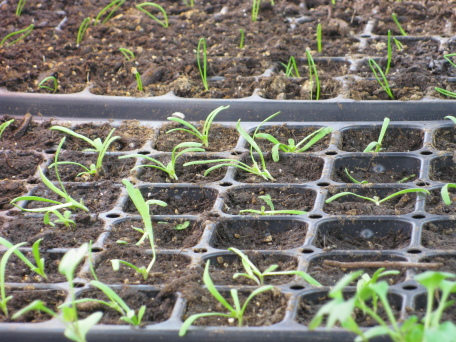
Ok and just one more tangent that I have to include is the fact that I built a picnic table/work table all by myself! Ah, the things I get excited about.
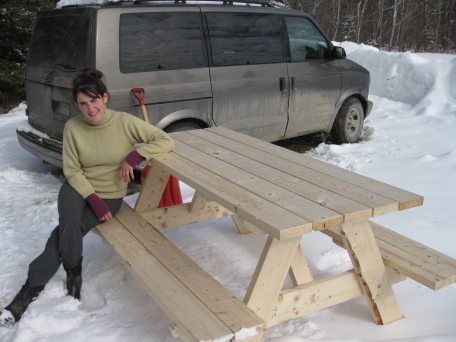
Happy Spring everyone!
Phase Two and Potting Soil
by jericho | February 19, 2012 at 10:38 AM | categories: vermont, maine, garden | View CommentsOn Friday, February 10th we headed to Maine with an extremely full van. I had to be careful to avoid bumps, or at least drive over them very slowly so as not to break an axle or anything. we definitely put the shocks to the test. But we made it! I thought I would include a few pictures of the inside of my cabin in Vermont (by request) and then move on to some pictures of our new home (Phase Two) in Dover-Foxcroft.
Here's the VT cabin:
And here is the Dover-Foxcroft cabin:
The cabin in Dover-Foxcroft was built by Nick and Lori Calderone (JP's parents) about 30 years ago. It is a lovely little two-floor building and they did much of the work with a chainsaw which makes it even more impressive!
You may notice that the pantry looks a bit like the inside of a shower stall. That's because it is the inside of a shower stall. At one point Lori did have running water hooked up, but now we haul our water from the hand pump just outside so I decided to re-purpose the shower. Every bit of space counts!
In the midst of getting settled in and learning the ropes of living without power and running water (which is wonderful, but takes a lot more time and planning than the alternative), our potting soil from Vermont Compost arrived!
I had figured that we would be using a little over one yard of potting soil for our garden this year. However, when I looked around at purchasing options it was actually going to be cheaper to buy two yards in bulk from Vermont Compost than to try buying individual bags of potting soil elsewhere. I knew that this would be quite a lot of potting soil, but assumed it would come on a big dump-type truck which would be tricky if the roads were muddy, but shouldn't have a problem getting down the driveway. Instead, it came on a tractor trailer!! Luckily, they hadn't posted the roads yet (they are posted now).
We spent some time at the end of the driveway discussing the possibilities with the truck driver because we weren't sure he could even fit in the driveway. But he was willing to give it a try and sure enough, with some seriously precise driving he made it! Now we have a giant marshmallow of potting soil waiting for ou very first seeds. It is a little hard to believe, but those seeds are actually scheduled to be planted this weekend. Giant Kohlrabi I believe. And then onions next week. So it begins...
Happy planting everyone!
Seeding
by jean-paul | February 19, 2012 at 10:38 AM | categories: maine, seeding, garden | View CommentsUp here at name-to-be-decided farm, Wednesday brought with it the official beginning of our growing season. Jericho and I seeded a tray of Kohlrabi (German turnip) (Brassica oleracea Gongylodes group) (a low, stout cultivar of the cabbage that will grow almost anywhere). Actually, we didn't quite seed the full tray; our spring planting only called for 3/4ths of a tray. I suspect that ridiculously small tasks will be the theme of this growing season.
Last fall we began our crop plan for this year. We strove for diversity and aimed for a yield which would produce enough to feed ourselves and provide a little extra for nearby family members. We're still tweaking the plan a little bit, but since we've actually bought our seeds already, only a few variables are still open to change.
On the goal of diversity, our plan calls for over fifty varieties of vegetables, representing almost forty distinct kinds of produce (forgive the awkward language here; at points you might expect me to say "species" I can't, since (for example) Kohlrabi, Cauliflower, Broccoli, Brussels Sprouts, Kale, Cabbage, and Turnips - all of which we'll be growing - are actually all of the same species; other words like cultivar also fail to capture the whole picture).
With such a variety of seeds, particularly when considering succession planting for continuous harvest, and (roughly) only ourselves as consumers, we'll be seeding one tray at a time for the majority of our plantings. Having WFCF volunteering as my only previous experience seeding flats, where three or four or five people would spend one or two or three hours seeding flats, I find this rather amusing. Jericho and I seeded our 3/4ths flat of Kohlrabi (together!) in about 45 seconds (the following part, where I dropped it, was not as amusing).
Another consequence of the wide variety is that we have a lot of information to manage: about what seeds to order, and in what quantities; about when to seed, when to transplant, when to harvest; about how many flats we'll need, how much space we'll need for crops. Since I love software (all of it, all the time), and as there appeared to be a rather sparse offering for this purpose, I wrote some to help out with planning these things out. It has given us a good framework (not always to be trusted, at least not yet) within to work for our early tasks. Hopefully before we get really busy, I'll have worked out the significant remaining bugs and we can actually rely on it. I've written more about the nitty gritty on my other blog, so as not to bore those of you not interested in such things.
Interspersed with these light agricultural duties, we've been walking in the woods (including one particularly beautiful walk a couple days ago right after a newly arrived half foot of snow), continuing to settle in to the cabin, and I've been preparing for (another!) trip to California. I have a short walk from our cabin to where there is electricity which serves as my commute.
I'm making this walk two to four times a day, which I hope is as exercise-y as it feels, since I'm supposed to be training for a 5k (in just under two weeks), but I have little hope of actually running anywhere in the vicinity any time soon.
How Lovely To Be A Chicken...
by jericho | February 16, 2012 at 11:36 AM | categories: vermont, chickens | View CommentsWith yurt construction wrapped up, Jean-Paul and I were ready to pack up the van (again) and head east to begin Phase Two of our big adventure. Before heading out though, we helped Dad slaughter a few chickens to pare down the flock a bit. I think that there were about 13 hens and 1 rooster, but we were only getting 4-6 eggs per day so obviously a few of the ladies weren't pulling their weight and had to go. But how to know which hens were laying and which weren't?!?!
Well, Dad found an article from Backyard Poultry (a magazine to which he subscribes) which explained how to tell if your hen is laying eggs. Here are the signs according to them: somewhat less yellow legs than hens that are not laying; a bright red, waxy comb; a moist vent with supple skin; and something about the pubic bones that I can't remember. The first hen that we pulled out seemed to exhibit all of these signs, but Dad said "well, I'd like to get rid of this one anyway." so on to the chopping block she went.
My favorite part of this slaughtering endeavor was the method for heating water that you can see in the picture above. Yes, that is a flame weeder pointed at a trash can full of water. Brilliant...and terrifying.
The only step we didn't get a picture of here is the plucking, which is too bad because that is really where the magic happens: when you turn a fully feathered chicken into something that looks like what is in your freezer. It is also very messy and the feathers stick to you fingers which makes it very difficult to take pictures.
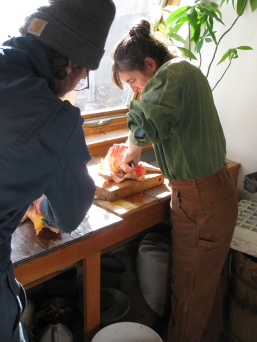
We found quite a few partially formed eggs (and one fully formed!) during evisceration indicating that the Backyard Poultry methods worked! oh..wait...
As it turned out, the oldest hens (and thus the best candidates for slaughter) seemed to all still be laying, but perhaps now that they are out of the picture, the newer hens will step up to the plate. Only time will tell.
« Previous Page -- Next Page »
